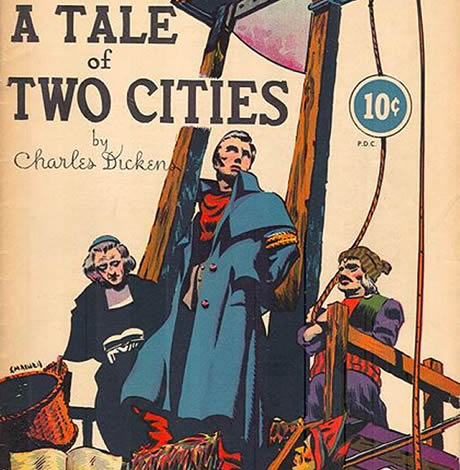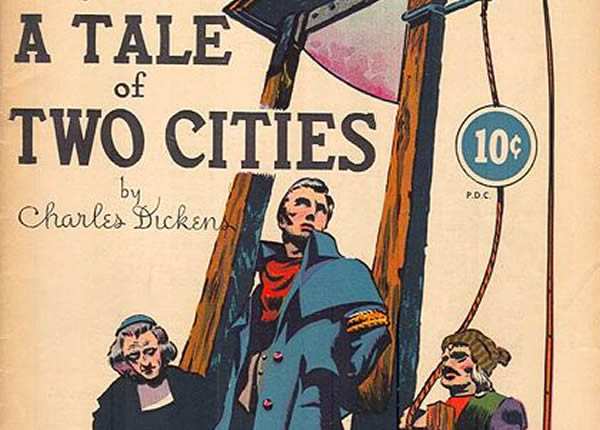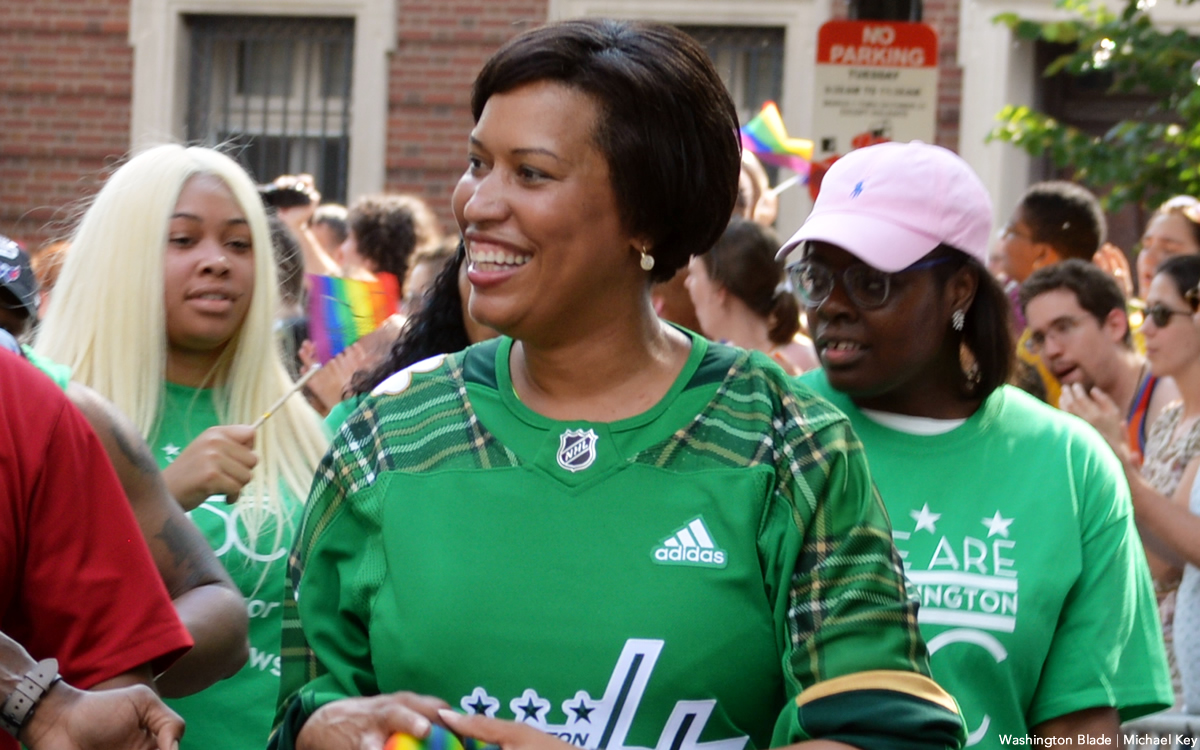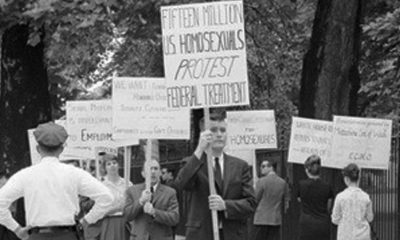Opinions
2014 was best — and worst — of times
Year brought ‘trans tipping point’ but tragedy in Ferguson


(Image public domain)
“I wish you would make up your mind, Mr. Dickens,” an editor says to Charles Dickens in an iconic New Yorker cartoon, “Was it the best of times or was it the worst of times?”
Last year was the best and the worst of times.
Writing this, I hear on the news that same-sex marriage is now legal in Florida, our country’s third largest state. A couple that has been together for 40 years talks about being able, finally, to marry. Now, same-sex couples can marry in 36 states, plus Washington, D.C. President Obama signed an executive order prohibiting federal contractors from engaging in discrimination based on sexual orientation and gender identity.
Last year proved once again that coming out still matters in our culture where homophobia is all too alive and well. Apple CEO Tim Cook became the first Fortune 500 CEO to come out. You’d have had to be made of stone not to have been inspired when Cook said, “I’m proud to be gay, and I consider being gay among the greatest gifts God has given me.”
I know nothing about football, but I was among the many in 2014 who were thrilled when Michael Sam became the first openly gay player to be drafted by the National Football League. A kiss may, as the song says, be “just a kiss.” But it was a lot more than that when Sam kissed his boyfriend to celebrate his having been drafted by the St. Louis Rams. The Rams later cut him, but “the kiss” will live on forever.
Kudos to “Orange is the New Black” star Laverne Cox! It takes a star to make the cover of Time magazine. As Time’s caption said, it was “The Transgender Tipping Point.”
Props to Pope Francis. An institution like the Catholic Church won’t quickly or easily change its attitudes toward LGBT people. Yet, the Pope has (partly) opened the church’s long-closed windows (toward acceptance and inclusion of LGBT people).
Unfortunately, there was much to decry in 2014. Who among us will ever forget Ferguson and the police killings of Michael Brown, Eric Garner and John Crawford III and the failure of grand juries to indict the police involved in these shootings? Like many of us, I’m appalled by these shootings, and I hope that I’m not racist. Yet, an article in the January/February issue of Mother Jones tells how research shows that most of us have “racial” biases that “we cannot consciously control.” More than half (51 percent) of those who take the Implicit Association Test, an online test that measures unconscious racial prejudices, “show moderate to strong bias,” the magazine reports.
Racism is still entrenched in the culture at large and in the LGBT community. Yet, there’s a glimmer of hope. “Research suggests that once we understand the psychological pathways that lead to prejudice, we just might be able to train our brains to go in the opposite direction,” writes Chris Mooney, author of the Mother Jones piece.
If I could get everyone to read one book, it would be Charles M. Blow’s memoir “Fire Shut Up in My Bones.” Blow writes of growing up, black and dirt-poor in rural Louisiana. Political issues of race, poverty and sexuality become engagingly personal in his work.
As the Blade reported in its yearlong series, poverty is a searing reality for many – from youth to elders – in the LGBT community.
LGBT people still have no federal protection against employment discrimination. We can be fired just for being queer in 29 states.
Creative artists – from actors to poets – make art no matter what the year. Highlights from 2014 for me included seeing the Shakespeare Theatre in Washington, D.C.’s production of Noel Coward’s “Private Lives;” interviewing poet Venus Thrash for the Blade; and watching Lily Tomlin receive a Kennedy Center Honor on TV.
It’s tempting, with all the bad news, to give in to despair. But, in the spirit of the New Year, let’s do what we can. Some ideas: Volunteer with Food and Friends, donate to Different Drummers, or support Split This Rock – the D.C. organization that fosters a national network of socially engaged poets.
Here’s to a better 2015!
Kathi Wolfe, a writer and poet, is a regular contributor to the Blade.

Thank you, Mayor Muriel Bowser, for all you have done for our beautiful city. I am proud to say I have been a supporter of yours since you first announced your run for City Council in Ward 4, when you took some of my suggestions for your first speech. I have known since then what an amazing woman, politician, leader, and now mother, you are. You have moved our city forward in so many ways no one could have anticipated when you were first elected.
You have always proven your mettle, and your ability to rise above the chaos, and done the right thing for all the people of the District. Whether it was during economic uncertainty created by others, the pandemic, the backlash against police after the murder of George Floyd, during the first Trump administration, or the ongoing crisis, continuing today after the felon was elected for a second time. This time, contrary to his first term, he has even more venal people around him. They are acting out their fascist beliefs, and directing him, as he threatens the very basis of home rule. You have stood your ground, and done it with grace and smarts. You managed to work through the budget crisis, and Congress’s attempt to derail all the progress you have made, by not letting us spend a billion dollars of our own money. You have been walking a tightrope, and managing to keep our city from falling into his hands. Not everyone has understood how difficult that has been.
Then you managed to get James Comer (R-Ken.), chair of the House Oversight Committee, to support your efforts to have 180 acres of valuable land, the RFK site, turned over to the District for redevelopment. After that, you achieved your goal of getting the Commanders to agree to move back to D.C.; in the process securing the largest private investment ever for the District, the $3.7 billion the team’s owners agreed to pay to build a new domed stadium. That being only the catalyst for an entire new community with 6,000 units of housing, including affordable housing, a supermarket, hotel, sports complex for students in D.C., parks, nature trails, and more.
While balancing budgets and fighting crime, you have had to deal with the felon in the White House every day. Some accused you of acquiescing to the felon when what you were actually doing was saving our city from the even worse disasters he could visit upon us.
You understood to rebuild the economy Trump and the pandemic worked to destroy, you needed to look at other options. You rightly determined part of what D.C. needed to grow was a sports economy. When Monumental Sports owner Ted Leonsis was trying to move the Capitals and his business out of the District for pure greed; you worked behind the scenes and successfully kept them here. Prior to that you engineered a public/private partnership between the city, and DC United, to get Audi field built.
Then besides sports you have worked with the private sector to begin the work of converting empty office buildings in the downtown area, into apartments, which will generate new needed taxes for the District. You oversaw the reconstruction of the Frederick Douglass Memorial Bridge, and the redevelopment of the South Capitol Street corridor. Along with all this you have overseen the rebuilding of schools, sports fields, recreation centers, and libraries across the city. In the past five years you have added nearly 10,000 affordable housing units in the District, built new shelters for the homeless, and a new hospital in Southeast D.C.
You have fought for fairness and equality for the LGBTQ community. You didn’t just walk in our parades, but worked to make them successful. You added budget money to build a new LGBTQ community center, and money to support WorldPride, while the felon’s policies threatened it in every way. After years of many of us trying to get the city to take responsibility, and fund, the annual High Heel Race, you were the mayor who finally agreed to do it. You have always stood proudly with the LGBTQ community that I am a part of, in large and small ways, both in public and privately.
You now have one more year to serve as mayor, and I can’t wait to see what you will yet accomplish. It will not be an easy time, as we saw the day after you announced you would not run again. You, and we, faced the tragic shooting of the two National Guard members from West Virginia, who walked our streets at the felon’s orders. But I am confident your energy and drive, your smarts, and understanding of people, will allow you to deal with this and won’t let you stop working for us until the minute the next mayor of the District of Columbia is sworn in at noon, Jan. 1, 2027.
It is clear to all of us, that person, he, or she, will have very large shoes to fill. Mayor Bowser, we all owe you a debt of gratitude for all you have done for D.C. I for one look forward to all you will do in the future; in whatever area you choose to work. I know your work is far from done.
Peter Rosenstein is a longtime LGBTQ rights and Democratic Party activist.

Today, on World AIDS Day, we honor the resilience, courage, and dignity of people living with HIV everywhere especially refugees, asylum seekers, and queer displaced communities across East Africa and the world.
For many, living with HIV is not just a health journey it is a journey of navigating stigma, borders, laws, discrimination, and survival.
Yet even in the face of displacement, uncertainty, and exclusion, queer people living with HIV continue to rise, thrive, advocate, and build community against all odds.
To every displaced person living with HIV:
• Your strength inspires us.
• Your story matters.
• You are worthy of safety, compassion, and the full right to health.
• You deserve a world where borders do not determine access to treatment, where identity does not determine dignity, and where your existence is celebrated not criminalized.
Let today be a reminder that:
• HIV is not a crime.
• Queer identity is not a crime.
• Seeking safety is not a crime.
• Stigma has no place in our communities.
• Access to treatment, care, and protection is a human right.
As we reflect, we must recommit ourselves to building systems that protect not punish displaced queer people living with HIV. We must amplify their voices, invest in inclusive healthcare, and fight the inequalities that fuel vulnerability.
Hope is stronger when we build it together.
Let’s continue to uplift, empower, and walk alongside those whose journeys are too often unheard.
Today we remember.
Today we stand together.
Today we renew hope.
Abraham Junior lives in the Gorom Refugee Settlement in South Sudan.
Commentary
Perfection is a lie and vulnerability is the new strength
Rebuilding life and business after profound struggles

I grew up an overweight, gay Black boy in West Baltimore, so I know what it feels like not to fit into a world that was not really made for you. When I was 18, my mother passed from congestive heart failure, and fitness became a sanctuary for my mental health rather than just a place to build my body. That is the line I open most speeches with when people ask who I am and why I started SWEAT DC.
The truth is that little boy never really left me.
Even now, at 42 years old, standing 6 feet 3 inches and 225 pounds as a fitness business owner, I still carry the fears, judgments, and insecurities of that broken kid. Many of us do. We grow into new seasons of life, but the messages we absorbed when we were young linger and shape the stories we tell ourselves. My lack of confidence growing up pushed me to chase perfection as I aged. So, of course, I ended up in Washington, D.C., which I lovingly call the most perfection obsessed city in the world.
Chances are that if you are reading this, you feel some of that too.
D.C. is a place where your resume walks through the door before you do, where degrees, salaries, and the perfect body feel like unspoken expectations. In the age of social media, the pressure is even louder. We are all scrolling through each other’s highlight reels, comparing our behind the scenes to someone else’s curated moment. And I am not above it. I have posted the perfect photo with the inspirational “God did it again” caption when I am feeling great and then gone completely quiet when life feels heavy. I am guilty of loving being the strong friend while hating to admit that sometimes I am the friend who needs support.
We are all caught in a system that teaches us perfection or nothing at all. But what I know for sure now is this: Perfection is a lie and vulnerability is the new strength.
When I first stepped into leadership, trying to be the perfect CEO, I found Brené Brown’s book, “Daring Greatly” and immediately grabbed onto the idea that vulnerability is strength. I wanted to create a community at SWEAT where people felt safe enough to be real. Staff, members, partners, everyone. “Welcome Home” became our motto for a reason. Our mission is to create a world where everyone feels confident in their skin.
But in my effort to build that world for others, I forgot to build it for myself.
Since launching SWEAT as a pop up fundraiser in 2015, opening our first brick and mortar in 2017, surviving COVID, reemerging and scaling, and now preparing to open our fifth location in Shaw in February 2026, life has been full. Along the way, I went from having a tight trainer six pack to gaining nearly 50 pounds as a stressed out entrepreneur. I lost my father. I underwent hip replacement surgery. I left a relationship that looked fine on paper but was not right. I took on extra jobs to keep the business alive. I battled alcoholism. I faced depression and loneliness. There are more stories than I can fit in one piece.
But the hardest battle was the one in my head. I judged myself for not having the body I once had. I asked myself how I could lead a fitness company if I was not in perfect shape. I asked myself how I could be a gay man in this city and not look the way I used to.
Then came the healing.
A fraternity brother said to me on the phone, “G, you have to forgive yourself.” It stopped me in my tracks. I had never considered forgiving myself. I only knew how to push harder, chase more, and hide the cracks. When we hung up, I cried. That moment opened something in me. I realized I had not neglected my body. I had held my life and my business together the best way I knew how through unimaginable seasons.
I stopped shaming myself for not looking like my past. I started honoring the new ways I had proven I was strong.
So here is what I want to offer anyone who is in that dark space now. Give yourself the same grace you give everyone else. Love yourself through every phase, not just the shiny ones. Recognize growth even when growth simply means you are still here.
When I created SWEAT, I hoped to build a home where people felt worthy just as they are, mostly because I needed that home too. My mission now is to carry that message beyond our walls and into the city I love. To build a STRONGER DC.
Because strength is not perfection. Strength is learning to love an imperfect you.
With love and gratitude, Coach G.
Gerard Burley, also known as Coach G, is a D.C.-based fitness entrepreneur.
-

 India4 days ago
India4 days agoIndia’s Jharkhand state works to improve trans people’s access to health care
-

 Commentary4 days ago
Commentary4 days agoPerfection is a lie and vulnerability is the new strength
-

 District of Columbia2 days ago
District of Columbia2 days agoHIV/AIDS activists block intersection near White House
-

 Movies3 days ago
Movies3 days agoHoliday movie season off to a ‘Wicked’ good start



















